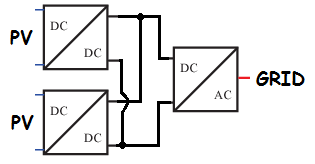Manufacturers datasheets are for promoting sales and therefore normally show the best-case scenarios.
My guess would be that these efficiencies are measured utilizing only 1 of the 2 MPPTs. You should consider additional losses in the case of using two MPPTs.
Just as a side note: You are interested in a single operational point which may be valid when you have clear skys, an ambient temperature of 20ºC and the suns angle provides an incident radiation of 800W/m2 on the panels. PV Panel Characteristics change with temperature, age, radiation amoung other factors.
There are many arquitectures out there. But in Multi/Poly MPPTs usually you have
- a DC/DC converter stage and
- a DC/AC Inverter stage.
Just a couple configuration examples:


There are others, but just to give a couple examples..
- You have a DC/DC boost/buck stage for each MPPT
a. This regulates each MPPT PV input voltage to make the common DC bus voltage (Input to Inverter Stage)
- then a DC/AC Inverter stage.
a. depending on the Grid Impedance, AC output voltage, the phase angle (amount of reactive power), amoung others, the optimal DC BUS voltage for the inverter will differ. In the case of cos phi = 1 and 230 Vac, typically you will want something like 230*sqrt(2)+15V margin. But that will depend on the architecture and the losses which have been classified for each stage. perhaps there are greater losses operating the DC/DC stage at one voltage compared to the AC/DC operating at another and the inverter may adjust to its calibrated/configured optimal operating points.
Other Configurations
Some inverters with two stages may have:
1st Stage (DC/DC): Buck-Bosst to regulate to a common DC Buss voltage for the second (DC/AC) AC output Stage, as described above.
- In the case of multi-mppts you can see that each MPPT just operates at each Strings MPP and converts it to the desired/defined common DC-Bus Voltage.
1st Stage (DC/DC): Only Boost and the 2nd Stage (DC/AC) will be a kind of "Buck" / "Direct MPPT".
note : to have current flow from the inverter to the grid you need to a higher voltage than the grid and you can say approximately ((PWM rms voltage generated by inverter)-Grid Voltage)/(filter + Grid Impedance @ specific phase angle) = Current injected into the grid.
On top of that, perhaps the specific architecture is not compatible with such a big difference as you propose (800/270) between the independent MPPTs.
As you see it is not simple to give a precise general answer to this.
Quick Estimate:
As a quick guesstimate of efficiency, if that configuration were possible, I would do a weighted average:
710*8 = 5680 * (5680/8200 -> 0.69 Pr point --> 98% efficiency)
270*6 = 1620 * (1620/8200 -> 0.2 Pr point --> 95% efficiency)
Efficiency guesstimate would be the weighted average
= (5680*.98+1620*.95)/(5680+1620) ~ 97% efficiency
There will be more losses, so I would consider this as a maximum obtainable efficiency.
Again, I am not sure your suggested case scenario is a stable operating point of the inverter, I have a feeling that there is too big of a voltage difference between the two MPPT operational power points.
More Precise Estimate:
There is a popular PV Simulation software called PVSyst which has been since a while the industry goto package for simulation solar installations. This software simulates in great detail the different aspects of a PV Installation. The manufacturers develop simulation models for their components, be it PV Panel, Inverters, etc..
The inverter models are .OND files which the software takes as input to model the inverter. For Fronius specifically you can find their PVSyst Files Here . At this moment I get a ERR_CONNECTION_RESET response from the download links but an email to Fronius should be sufficient to get these files
Fronius has a Quick Guide on using PVSyst with some other model.
Creating your own Empirical Model of the inverter
There is a SANDIA REPORT, specifically , Performance Model for Grid-Connected
Photovoltaic Inverters - SAND2007-5036 which proposes an empirical fit to model inverters from field measurements performed. You could fit data provided by the datasheets to calculate this model.
Although this is not for a multi-mppt inverter it may provide another approach to estimate efficiencies.



